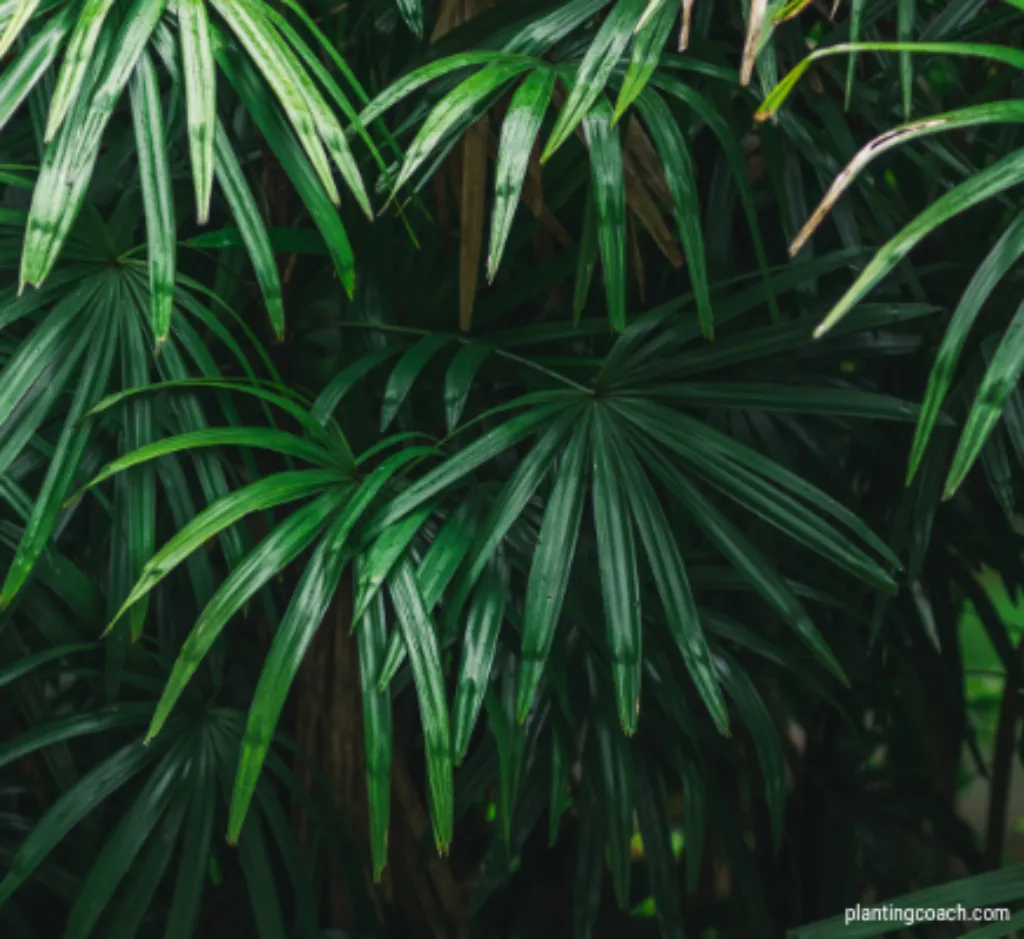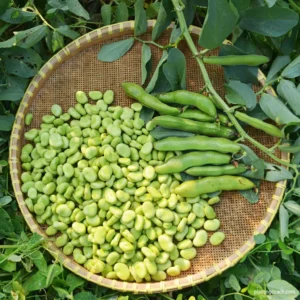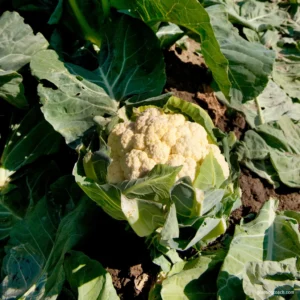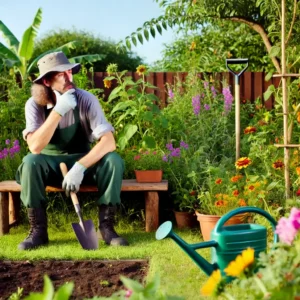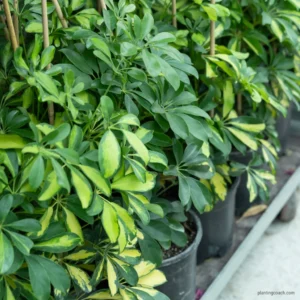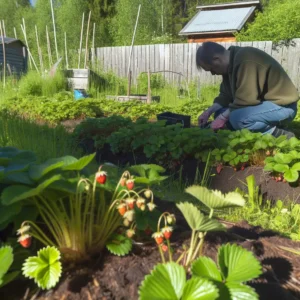The bamboo palm (Chamaedorea seifrizii) is celebrated for its lush, tropical appearance and its ability to purify the air. Popular among both indoor and outdoor gardening enthusiasts, this resilient plant brings a slice of nature’s tranquility into homes and gardens. Known for its bamboo-like stalks and feathery leaves, the bamboo palm tree is a fantastic addition to any green space. It improves the beauty of your home or garden and ensures fresh air quality by filtering out toxins.
The bamboo palm is relatively low-maintenance, making it an ideal choice for both new and experienced gardeners. In this article, we will explore everything about How to Grow and Care for Bamboo Palm, ensuring your plant thrives, whether it graces your living room or outdoor garden. From planting and watering to pruning and troubleshooting, you will find everything you need to know to keep your bamboo palm healthy and vibrant.
How to Grow and Care for Bamboo Palm
Essentials of Bamboo Palm Care
Understanding the essentials of bamboo palm care is the first step to ensuring a healthy and vibrant plant. The bamboo palm plant is relatively low-maintenance, making it an ideal choice for both beginner and experienced gardeners. Native to the rainforests of Central and South America, the bamboo palm thrives in environments that mimic its natural habitat – think shaded areas with high humidity.
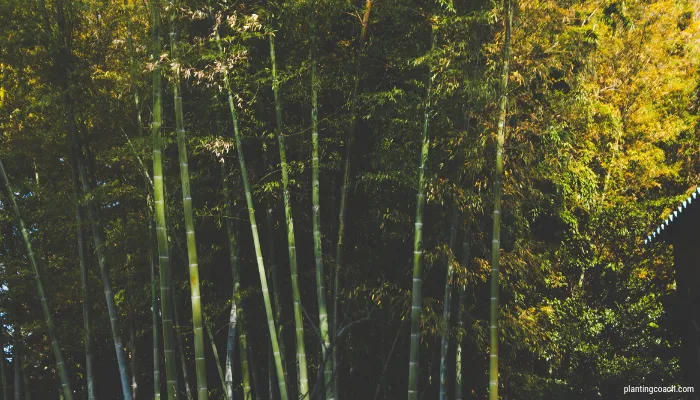
Bamboo palms are adaptable and can grow well in various light conditions but prefer bright, indirect light. Direct sunlight can scorch their leaves, while too little light can slow their growth. In terms of temperature, bamboo palms can adapt to various weathers but thrive best in a range of 65 to 80 degrees Fahrenheit.
Watering is crucial for bamboo palm care. These plants prefer consistently moist soil but can suffer from root rot if overwatered. Regular misting can help maintain the humidity levels they love. Fertilization during the growing season supports their rich growth, but it’s essential to avoid over-fertilizing, which can harm the plant.
Optimal Soil and Light Conditions for Bamboo Palm
Creating the perfect environment for your bamboo palm plant starts with the right soil and lighting conditions. Bamboo palms prefer well-draining soil that retains moisture without becoming waterlogged. A high-quality potting mix designed for palms or a blend of peat moss, perlite, and sand provides the ideal foundation for your plant.
When it comes to light, bamboo palms thrive in bright, indirect light. If you’re growing your bamboo palm indoors, place it near a north or east-facing window where it can receive filtered light. Too much direct sunlight can cause the leaves to burn, leading to unsightly brown tips. Conversely, while bamboo palms can tolerate lower light conditions, insufficient light can result in slower growth and less vibrant foliage.

For outdoor bamboo palms, choose a location that offers partial shade. Under the shade of taller trees or on the shaded side of your house are ideal spots. This setting mimics their natural habitat, where they grow under the protection of larger plants and trees.
Maintaining the right balance of light and soil conditions is essential for optimal bamboo palm care. Regularly check the soil moisture and adjust the watering schedule as needed, especially if the plant is in a particularly sunny or shaded spot. By providing the right soil and light conditions, you’ll set a strong foundation for your bamboo palm’s health and growth.
Planting and Repotting Bamboo Palm Plants
Proper planting and repotting are crucial steps in the lifecycle of bamboo palm plants. Whether you’re introducing a new bamboo palm to your home or repotting an existing one, following the correct procedures will ensure your plant continues to thrive.
Planting Bamboo Palms
When planting a bamboo palm outdoors, select a site that offers partial shade and protection from strong winds. Dig a hole that is twice as wide and just as deep as the root ball. Gently remove the plant from its nursery pot, taking care not to damage the roots. Place the bamboo palm in the hole and backfill it with a mixture of the original soil and organic compost to enrich the soil. Water thoroughly after planting to help settle the soil around the roots.

For indoor bamboo palms, choose a pot with drainage holes to prevent water from accumulating at the bottom. Fill the pot with a well-draining potting mix. Carefully remove the plant from its nursery pot and place it in the new pot, ensuring it is at the same depth as before. Fill in around the root ball with potting mix and water well to settle the soil.
Repotting Bamboo Palms
Repotting is an essential part of bamboo palms’ care as it provides fresh soil and more space for root growth. Generally, bamboo palms need to be repotted every 2-3 years or when they become root-bound. Signs that your bamboo palm needs repotting include roots growing out of the drainage holes and a noticeable slowdown in growth.

To re-pot, select a pot one size larger than the current one. Gently remove the bamboo palm from its pot and shake off excess soil from the roots. Place the plant in the new pot and fill around the root ball with fresh potting mix. Water thoroughly to help the plant settle in its new home.
Watering Strategies for Bamboo Palms
Watering is a critical aspect of bamboo palms’ care, requiring a balance between keeping the soil moist and avoiding waterlogging. Proper watering strategies will ensure your bamboo palm plant remains healthy and vibrant.
Indoor Bamboo Palm Watering
Indoor bamboo palms need consistent moisture but should not sit in waterlogged soil. Water your indoor bamboo palm when the top inch of soil feels dry to the touch. This typically means watering every 7-10 days, but the frequency can vary based on the indoor climate and pot size. Reduce watering during the winter months when the plant’s growth slows.
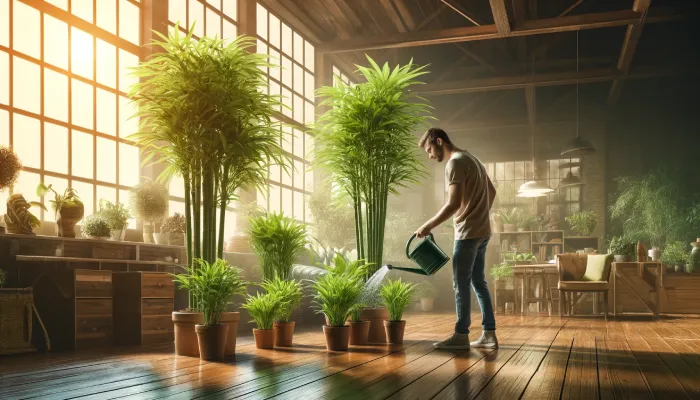
Use room-temperature water to avoid shocking the plant’s roots. Water thoroughly until you see water draining out of the bottom of the pot, then empty the saucer to prevent standing water. Regular misting or using a humidity tray can help maintain the humidity levels bamboo palms prefer.
Outdoor Bamboo Palm Watering
Outdoor bamboo palms also require consistent moisture, especially during dry periods. Water the plant deeply, ensuring the water reaches the root zone. The frequency of watering depends on the weather and soil conditions, but generally, watering once or twice a week is sufficient. During hot, dry spells, increase the frequency to keep the soil consistently moist.
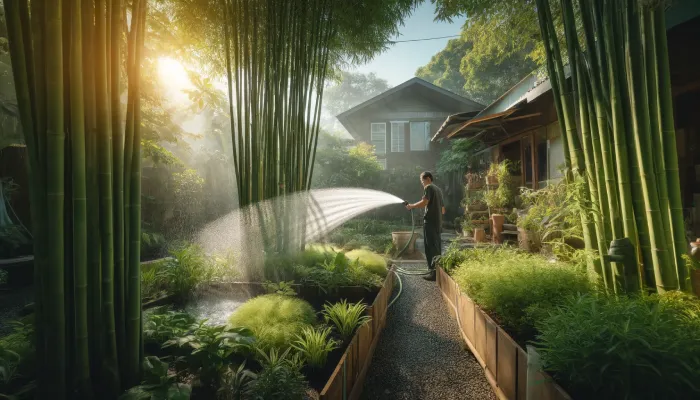
A good mulching layer around the base of the plant can help retain soil moisture and reduce the need for frequent watering. However, be careful not to pile mulch against the stem, which can lead to rot.
Signs of Overwatering and Underwatering
Overwatering can lead to root rot, a common problem in bamboo palms. Signs of overwatering include yellowing leaves, wilting, and a foul smell from the soil. If you suspect overwatering, allow the soil to dry out before watering again, and ensure the pot has proper drainage.

Underwatering, on the other hand, can cause the leaves to dry out and turn brown at the tips. If your bamboo palm is underwatered, you’ll notice dry, crispy leaves and a general lack of vigor. Adjust your watering schedule to ensure the plant receives consistent moisture.
Fertilizing Your Bamboo Palm Plant
Fertilizing is an essential part of bamboo palm plant care, providing the nutrients needed for healthy growth and vibrant foliage. A well-balanced fertilization routine will support your plant throughout its growing season.
Choosing the Right Fertilizer
For bamboo palms, a balanced, water-soluble fertilizer is ideal. Look for a fertilizer with equal parts nitrogen, phosphorus, and potassium (NPK), such as a 10-10-10 or 20-20-20 formula. These balanced fertilizers provide the essential nutrients needed for robust growth and lush green leaves.
Fertilization Schedule
During the growing season, typically from spring through early fall, fertilize your bamboo palm every four to six weeks. This regular feeding schedule ensures the plant has a consistent supply of nutrients to support its growth. In the winter months, reduce or stop fertilizing as the plant’s growth slows and its nutritional needs decrease.
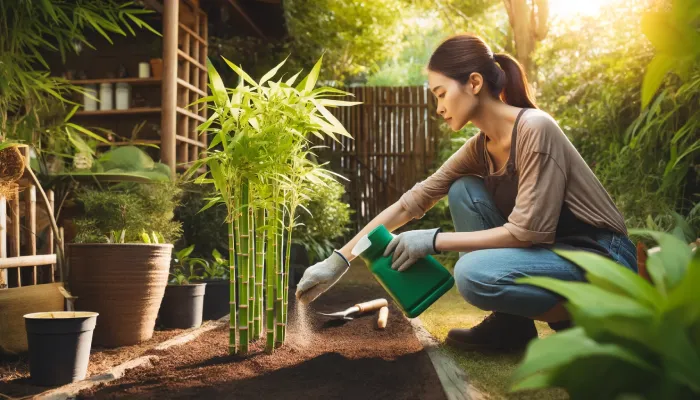
Fertilizer Application Tips
When applying fertilizer, always follow the manufacturer’s instructions for dilution and application rates. Over-fertilizing can lead to nutrient burn, which damages the plant’s roots and foliage. It’s better to under-fertilize slightly than to overdo it. Water the plant thoroughly before and after applying fertilizer to help distribute the nutrients evenly and prevent root burn. For indoor plants, using a water-soluble fertilizer allows you to control the application more precisely and avoid buildup in the soil.
Signs of Nutrient Deficiency
Bamboo palms can show signs of nutrient deficiency if not fertilized properly. Yellowing leaves, slow growth, and pale or discolored foliage are common symptoms. If you notice these signs, assess your fertilization routine and consider adjusting the frequency or type of fertilizer used.
Pruning and Maintenance of Bamboo Palm Tree
Regular pruning and maintenance are essential to keep your bamboo palm tree looking its best and to encourage healthy growth. Proper care will help maintain its attractive appearance and prevent potential issues.
Pruning Tips
Pruning helps remove dead or damaged fronds, encouraging new growth and maintaining the plant’s overall health. Use clean, sharp scissors or pruning shears to make precise cuts, avoiding jagged edges that can lead to infections.
- Remove Dead Fronds: Regularly check your bamboo palm for yellow or brown fronds and remove them at the base. Dead fronds can attract pests and diseases, so prompt removal is crucial.
- Trim Spent Flowers: If your bamboo palm produces flowers, trim them off once they start to wilt. This practice prevents the plant from expending energy on seed production and redirects it to foliage growth.
- Shape the Plant: Prune to shape the plant and control its size, especially for indoor bamboo palms. Trim back any overly long or leggy stems to maintain a balanced and attractive appearance.

Maintenance Practices
In addition to pruning, regular maintenance will keep your bamboo palm tree healthy and vibrant.
- Cleaning the Leaves: Dust can accumulate on the leaves of indoor bamboo palms, reducing their ability to photosynthesize. Wipe the leaves gently with a damp cloth or use a gentle shower to clean them.
- Checking for Pests: Regularly inspect your bamboo palm for pests like spider mites, mealybugs, and scale. Early detection and treatment with insecticidal soap or neem oil can prevent infestations from spreading.
- Humidity Control: Bamboo palms thrive in humid environments. Use a humidifier, mist the leaves regularly, or place a humidity tray near the plant to maintain adequate moisture levels.
- Monitoring Soil Moisture: Keep an eye on the soil moisture and adjust your watering schedule as needed. Ensure the soil remains consistently moist but not waterlogged.
Propagation Techniques for Bamboo Palm Plants
Propagating bamboo palm plants can be a rewarding way to expand your collection or share with friends. There are two main methods of propagation: by seeds and by division. Each method has its advantages and specific steps to follow for success.
Propagation by Seeds
Growing bamboo palms from seeds can be a slow process, but it is rewarding for patient gardeners.
- Collecting Seeds: If your bamboo palm produces seeds, collect them once they are fully mature and dry. Alternatively, you can purchase seeds from a reputable supplier.
- Preparing Seeds: Soak the seeds in warm water for 24 hours to soften the outer shell and encourage germination.
- Planting Seeds: Fill small pots or seed trays with a well-draining potting mix. Plant the seeds about 1/2 inch deep and cover lightly with soil.
- Germination: Place the pots in a warm, humid environment with indirect light. Keep the soil consistently moist but not waterlogged. Germination can take several weeks to a few months, so patience is key.
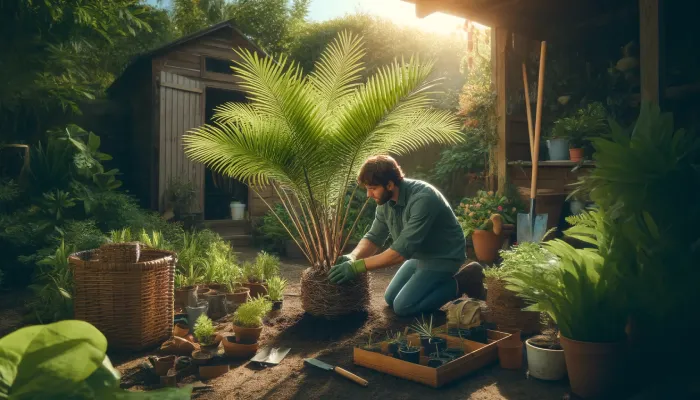
Propagation by Division
Division is a quicker and more reliable method for propagating bamboo palms, especially if you have a mature plant with multiple stems.
- Selecting a Plant: Choose a healthy, mature bamboo palm with multiple stems or offshoots.
- Preparing for Division: Water the plant thoroughly a day before dividing to reduce stress on the roots.
- Dividing the Plant: Carefully remove the plant from its pot and gently separate the root ball into smaller sections, ensuring each section has roots attached. Use a clean, sharp knife if necessary.
- Planting Divisions: Pot each division in a separate container with fresh, well-draining potting mix. Water thoroughly and place in a location with bright, indirect light.
- Aftercare: Maintain consistent moisture and humidity levels as the new plants establish themselves. Avoid fertilizing for the first few weeks to prevent root burn.
Seasonal Bamboo Palm Care Challenges
Caring for bamboo palms throughout the year involves adjusting your routine to address seasonal changes. Each season presents unique challenges and opportunities for maintaining the health of your bamboo palm tree.
Spring and Summer Care
Spring and summer are the primary growing seasons for bamboo palms. During this time, your plant will be more active and require more attention.
- Increased Watering: As temperatures rise, the soil will dry out faster. Increase your watering frequency to keep the soil consistently moist but not waterlogged.
- Fertilization: Regularly fertilize your bamboo palm every four to six weeks with a balanced, water-soluble fertilizer to support its growth.
- Pest Monitoring: Warmer weather can attract pests. Regularly inspect your plant for signs of infestations and treat promptly with insecticidal soap or neem oil.
- Humidity Maintenance: High humidity is crucial during the growing season. Mist the leaves regularly or use a humidity tray to keep the air around your plant moist.

Fall Care
As the weather cools, your bamboo palm’s growth will start to slow. This transitional period requires some adjustments to your care routine.
- Reduced Watering: Gradually reduce watering frequency as the plant’s growth slows. Ensure the soil remains slightly moist but not overly wet.
- Last Fertilization: Give your bamboo palm a final fertilization in early fall to support its health through winter.
- Clean-Up: Prune any dead or yellowing fronds and tidy up the plant to prepare it for the dormant period.
Winter Care
Winter presents unique challenges for bamboo palm indoor plants, especially in colder climates. Indoor bamboo palm care requires extra attention during this time.
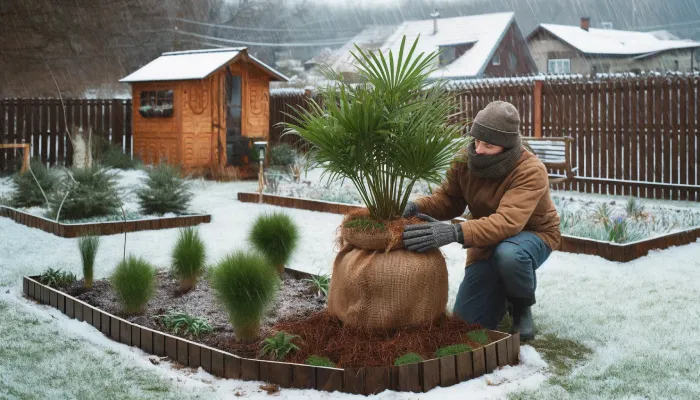
- Minimize Watering: Significantly reduce watering during the winter. Allow the top inch of soil to dry out between waterings.
- Avoid Drafts: Keep your bamboo palm away from cold drafts, heating vents, and direct heat sources, which can dry out the foliage.
- Maintain Humidity: Indoor air can become very dry in winter. Use a humidifier, mist the leaves regularly, or place a humidity tray near the plant to maintain adequate humidity levels.
- Monitor Light: Shorter days mean less natural light. If your bamboo palm doesn’t receive enough natural light, consider using a grow light to supplement lighting.
Common Pests and Problems with Bamboo Palm Plants
While bamboo palms are generally hardy, they can occasionally fall victim to pests and problems. Being vigilant and proactive in addressing these issues is crucial to bamboo palm plant care.
Common Pests
Several pests, including spider mites, mealybugs, and scale insects, can affect bamboo palms. Regular inspection and early intervention are key to managing these pests.
- Spider Mites: These tiny pests are often found on the undersides of leaves, where they spin fine webs. Signs of an infestation include yellowing leaves and fine webbing. Treat spider mites by spraying the plant with insecticidal soap or neem oil and increasing humidity around the plant.
- Mealybugs: Mealybugs appear as small, white, cotton-like masses on the leaves and stems. They can cause yellowing leaves and stunted growth. Remove mealybugs by wiping them off with a cotton swab dipped in rubbing alcohol, and treat the plant with insecticidal soap.
- Scale Insects: Scale insects are tiny, brown, shell-like pests that attach themselves to stems and leaves. They can cause yellowing leaves and reduced vigor. Remove scale insects by scraping them off with a soft brush and treating the plant with insecticidal soap or neem oil.

Common Problems
In addition to pests, bamboo palms can encounter several other issues that can affect their health.
- Yellowing Leaves: Yellow leaves can indicate overwatering, underwatering, or nutrient deficiencies. Check your watering schedule and ensure the plant is receiving balanced fertilization. Adjust light conditions if necessary.
- Brown Leaf Tips: Brown tips are often a sign of low humidity, underwatering, or excess salts from fertilizers. Increase humidity by misting the leaves or using a humidity tray, and flush the soil with water to remove excess salts.
- Root Rot: Root rot is caused by overwatering and poorly draining soil. Symptoms include wilting, yellowing leaves, and a foul smell from the soil. If you suspect root rot, reduce watering, improve drainage, and repot the plant in fresh, well-draining soil.
Preventive Measures
Preventing pests and problems is always easier than treating them. Here are some preventive measures to keep your bamboo palm healthy:
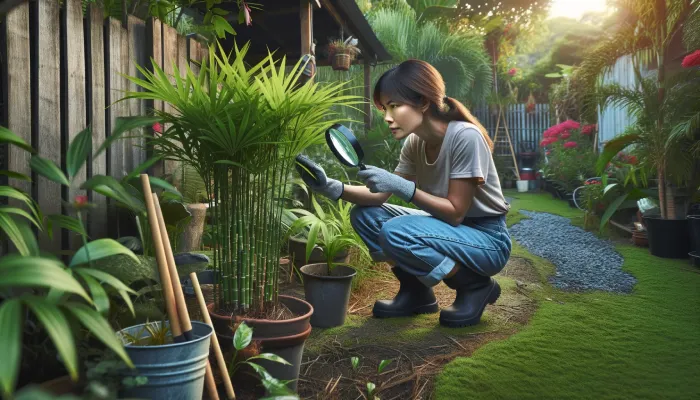
- Regular Inspections: Inspect your bamboo palm regularly for signs of pests or problems. Early detection allows for prompt treatment.
- Proper Watering: Follow a consistent watering schedule and ensure the soil drains well to prevent overwatering and root rot.
- Balanced Fertilization: Use a balanced fertilizer during the growing season and avoid over-fertilizing, which can cause nutrient imbalances and salt buildup.
- Maintain Humidity: Keep the humidity levels high around your plant, especially during the winter months when indoor air is dry.
Summary
Caring for a bamboo palm is a rewarding experience that brings the beauty and tranquility of a tropical plant into your home or garden. By understanding and meeting the specific needs of your bamboo palm plant, you can ensure it thrives and remains a vibrant part of your green space. Whether you’re planting a new bamboo palm, repotting an existing one, or managing its seasonal care, following the guidelines outlined in this article will help you provide the best possible care for your plant. From proper watering and fertilization to pruning and pest management, each aspect of bamboo palm care contributes to its overall health and beauty.
FAQ
Q1: How do you care for a bamboo palm plant?
To care for a bamboo palm plant, provide bright, indirect light and water when the top inch of soil is dry, maintain high humidity, and fertilize monthly during the growing season. Prune dead fronds and keep the plant away from drafts and direct sunlight.
Q2: Where is the best place for bamboo palms?
The best place for bamboo palms is in a location with bright, indirect light, such as near a north or east-facing window indoors or in a shaded or partially-shaded spot outdoors.
Q3: Why is my bamboo palm turning yellow?
Yellowing leaves on a bamboo palm can be caused by overwatering, underwatering, poor drainage, low humidity, or nutrient deficiencies. Check your watering schedule, improve soil drainage, and consider adjusting humidity levels and fertilization.
Q4: Do bamboo palms need sunlight?
Bamboo palms need bright, indirect sunlight. They can tolerate lower light conditions but will thrive best with ample indirect light. Avoid placing them in direct sunlight, as it can scorch their leaves.
Q5: What is the best fertilizer for palm trees?
The best fertilizer for palm trees, including bamboo palms, is a balanced, water-soluble fertilizer with equal parts nitrogen, phosphorus, and potassium, such as a 10-10-10 or 20-20-20 formula. Use it monthly during the growing season for optimal results.
